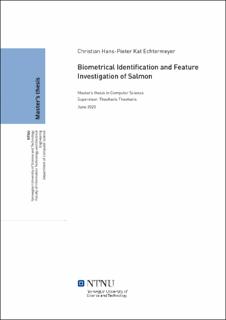| dc.contributor.advisor | Theoharis, Theoharis | |
| dc.contributor.author | Echtermeyer, Christian Hans-Pieter Kat | |
| dc.date.accessioned | 2021-09-15T16:15:09Z | |
| dc.date.available | 2021-09-15T16:15:09Z | |
| dc.date.issued | 2020 | |
| dc.identifier | no.ntnu:inspera:57320302:17623292 | |
| dc.identifier.uri | https://hdl.handle.net/11250/2777850 | |
| dc.description.abstract | Prikker danner unike mønster på mange forskjellige arter i dyreriket og har blitt brukt i kombinasjon med datasyn til å identifisere individer. I denne oppgaven beskrives prosessen av å skape en identifikasjonspipeline for laksegjenkjenning basert på prikkemønster. Pipelinen består hovedsaklig av tre deler: ekstrahering av biometriske trekk, konvertering av disse til numeriske beskrivelsesvektorer, og gjenkjenningsalgoritmen.
Trekkene blir ekstrahert ved bruk av tre forskjellige nevrale nettverk fra tidligere arbeid. Et unikt koordinatsystem ble konstruert ved hjelp av øye og et nytt ankerpunkt: brystfinnen til fisken. Lokasjon, form og størrelse av prikkene blir ekstrahert og lagret i en database for matching. En algoritme ble konstruert som oppnår lignende resultater som nåværende state-of-the-art, men ved bruk av mindre og kanskje mer pålitelige biometriske trekk. Et eksperiment ble gjennomført for å matche den største mengden unike laks til dags dato, 1000 unike identiteter, som oppnådde 96.83% true positive og setter dermed en ny grunnlinje. Et sikkerhetsvurderingssystem ble opprettet som åpner for en avveining mellom precision og recall. Dette arbeidet tilfører også en database med biometrisk data og trente nevrale nettverk for fremtidig arbeid. | |
| dc.description.abstract | Spots form unique patterns on many different species in the animal kingdom and have been used in combination with computer vision to identify individuals. This work creates an identification pipeline for salmon based on spot patterns located on the head of the fish. The pipeline primarily consists of three parts: extracting biometrical features, converting these into numerical feature vectors, and the matching algorithm itself.
The features are extracted using three different neural networks created previously. A unique coordinate system was constructed utilizing the eye and a novel anchor point: the pectoral fin. Location, shape, and size are extracted from the spots and saved in a database for matching. An algorithm was created, achieving similar results to the current state of the art, using less and possibly more reliable biometrical features. An experiment was conducted matching the largest number of unique salmon to date, containing 1000 unique identities and achieving a correct match percentage of 96.83%, setting a new baseline. A confidence rating was established, allowing for a customizable trade-off between precision and recall. The work also contributes a database containing biometrical features and trained neural networks for future work. | |
| dc.language | | |
| dc.publisher | NTNU | |
| dc.title | Biometrical Identification and Feature
Investigation of Salmon | |
| dc.type | Master thesis | |
